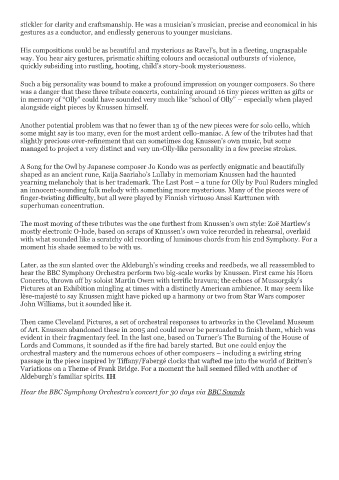Page 525 - Aldeburgh Festival 2022 FINAL COVERAGE BOOK
P. 525
stickler for clarity and craftsmanship. He was a musician’s musician, precise and economical in his
gestures as a conductor, and endlessly generous to younger musicians.
His compositions could be as beautiful and mysterious as Ravel’s, but in a fleeting, ungraspable
way. You hear airy gestures, prismatic shifting colours and occasional outbursts of violence,
quickly subsiding into rustling, hooting, child’s story-book mysteriousness.
Such a big personality was bound to make a profound impression on younger composers. So there
was a danger that these three tribute concerts, containing around 16 tiny pieces written as gifts or
in memory of “Olly” could have sounded very much like “school of Olly” – especially when played
alongside eight pieces by Knussen himself.
Another potential problem was that no fewer than 13 of the new pieces were for solo cello, which
some might say is too many, even for the most ardent cello-maniac. A few of the tributes had that
slightly precious over-refinement that can sometimes dog Knussen’s own music, but some
managed to project a very distinct and very un-Olly-like personality in a few precise strokes.
A Song for the Owl by Japanese composer Jo Kondo was as perfectly enigmatic and beautifully
shaped as an ancient rune, Kaija Saariaho’s Lullaby in memoriam Knussen had the haunted
yearning melancholy that is her trademark. The Last Post – a tune for Olly by Poul Ruders mingled
an innocent-sounding folk melody with something more mysterious. Many of the pieces were of
finger-twisting difficulty, but all were played by Finnish virtuoso Anssi Karttunen with
superhuman concentration.
The most moving of these tributes was the one furthest from Knussen’s own style: Zoë Martlew’s
mostly electronic O-lude, based on scraps of Knussen’s own voice recorded in rehearsal, overlaid
with what sounded like a scratchy old recording of luminous chords from his 2nd Symphony. For a
moment his shade seemed to be with us.
Later, as the sun slanted over the Aldeburgh’s winding creeks and reedbeds, we all reassembled to
hear the BBC Symphony Orchestra perform two big-scale works by Knussen. First came his Horn
Concerto, thrown off by soloist Martin Owen with terrific bravura; the echoes of Mussorgsky’s
Pictures at an Exhibition mingling at times with a distinctly American ambience. It may seem like
lèse-majesté to say Knussen might have picked up a harmony or two from Star Wars composer
John Williams, but it sounded like it.
Then came Cleveland Pictures, a set of orchestral responses to artworks in the Cleveland Museum
of Art. Knussen abandoned these in 2005 and could never be persuaded to finish them, which was
evident in their fragmentary feel. In the last one, based on Turner’s The Burning of the House of
Lords and Commons, it sounded as if the fire had barely started. But one could enjoy the
orchestral mastery and the numerous echoes of other composers – including a swirling string
passage in the piece inspired by Tiffany/Fabergé clocks that wafted me into the world of Britten’s
Variations on a Theme of Frank Bridge. For a moment the hall seemed filled with another of
Aldeburgh’s familiar spirits. IH
Hear the BBC Symphony Orchestra’s concert for 30 days via BBC Sounds

